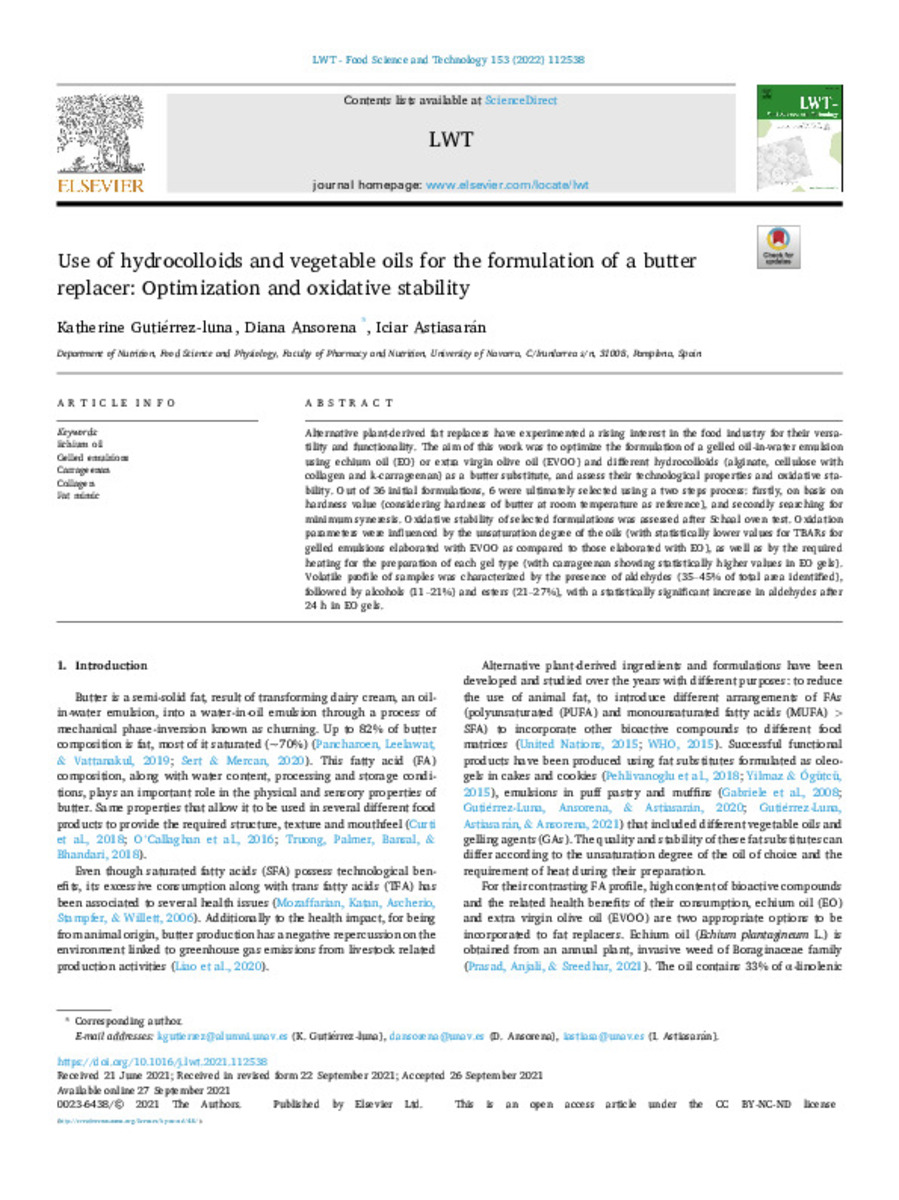Full metadata record
| DC Field | Value | Language |
|---|---|---|
| dc.creator | Gutiérrez-Luna, K. (Katherine) | - |
| dc.creator | Ansorena-Artieda, D. (Diana) | - |
| dc.creator | Astiasarán, I. (Iciar) | - |
| dc.date.accessioned | 2022-04-13T11:56:30Z | - |
| dc.date.available | 2022-04-13T11:56:30Z | - |
| dc.date.issued | 2022 | - |
| dc.identifier.citation | Gutiérrez-Luna, K. (Katherine); Ansorena-Artieda, D. (Diana); Astiasarán, I. (Iciar). "Use of hydrocolloids and vegetable oils for the formulation of a butter replacer: Optimization and oxidative stability". NWT. (153), 2022, 112538 | es_ES |
| dc.identifier.issn | 0023-6438 | - |
| dc.identifier.uri | https://hdl.handle.net/10171/63391 | - |
| dc.description.abstract | Alternative plant-derived fat replacers have experimented a rising interest in the food industry for their versa- tility and functionality. The aim of this work was to optimize the formulation of a gelled oil-in-water emulsion using echium oil (EO) or extra virgin olive oil (EVOO) and different hydrocolloids (alginate, cellulose with collagen and k-carrageenan) as a butter substitute, and assess their technological properties and oxidative sta- bility. Out of 36 initial formulations, 6 were ultimately selected using a two steps process: firstly, on basis on hardness value (considering hardness of butter at room temperature as reference), and secondly searching for minimum syneresis. Oxidative stability of selected formulations was assessed after Schaal oven test. Oxidation parameters were influenced by the unsaturation degree of the oils (with statistically lower values for TBARs for gelled emulsions elaborated with EVOO as compared to those elaborated with EO), as well as by the required heating for the preparation of each gel type (with carrageenan showing statistically higher values in EO gels). Volatile profile of samples was characterized by the presence of aldehydes (35–45% of total area identified), followed by alcohols (11–21%) and esters (21–27%), with a statistically significant increase in aldehydes after 24 h in EO gels | es_ES |
| dc.description.sponsorship | We are grateful to the PIUNA (Plan de Investigación de la Universidad de Navarra) for the financial support. K. Gutiérrez-Luna is grateful to “Asociación de Amigos de la Universidad de Navarra” for the grant received. | es_ES |
| dc.language.iso | eng | es_ES |
| dc.publisher | Elsevier | es_ES |
| dc.rights | info:eu-repo/semantics/openAccess | es_ES |
| dc.subject | Echium oil | es_ES |
| dc.subject | Gelled emulsions | es_ES |
| dc.subject | Carrageenan | es_ES |
| dc.subject | Collagen | es_ES |
| dc.subject | Fat mimic | es_ES |
| dc.title | Use of hydrocolloids and vegetable oils for the formulation of a butter replacer: Optimization and oxidative stability | es_ES |
| dc.type | info:eu-repo/semantics/article | es_ES |
| dc.description.note | This is an open access article under the CC BY-NC-ND license | es_ES |
| dc.identifier.doi | 10.1016/j.lwt.2021.112538 | - |
| dadun.citation.number | 153 | es_ES |
| dadun.citation.publicationName | NWT | es_ES |
| dadun.citation.startingPage | 112538 | es_ES |
Files in This Item:
Statistics and impact
Items in Dadun are protected by copyright, with all rights reserved, unless otherwise indicated.






